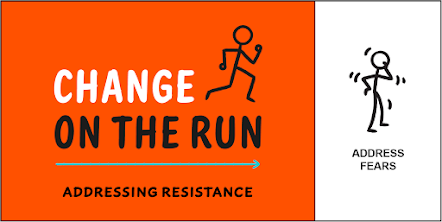This post's podcast episode is available on Sounder, Apple Podcasts, Google Podcasts, Stitcher and Spotify.
When you are short of time, here is the one action that will give you 80 percent results in 20 percent of the time.
DO THIS
Address concerns head-on.
BY DOING THIS
– Intently listen to concerns and objections.
– State what people appear to fear in one sentence.
– Honestly and openly communicate why this will or won’t happen, and what support they will get if it does.
It's natural for some people to resist change. The organization is asking them to exchange strongly held beliefs and routines for untested and uncomfortable ones. Resistance can take many forms—from indifference to not adopting new processes to sabotage—and you need to address all forms quickly or your progress will stall. People resist new ways of working for many reasons, including fear of the unknown, loss of control, being over-loaded, comfort with the present, disagreement with what’s new or lack of skills required to succeed.
The first step to minimizing resistance is to listen to people’s concerns intently. Their explanations will uncover their fears. Once identified, you can refute them by stating the facts (e.g., “No, we’re not moving the head office”), or explain why the change is necessary and what support will be provided (e.g., “We must move the head office to save money that will be reinvested in new product development. We’ll help you move”).
KNOWLEDGE BITES
OVERCOMING RESISTANCE PLANNER: What are the sources of resistance and how will I manage them?
SUCCESS TIP
Identify concerns during the planning stage to proactively address sources of fear and mitigate implementation risks.
To learn about the Change on the Run book go to http://www.changeontherun.com. Pre-order bonuses are available from February 2 - March 2.



